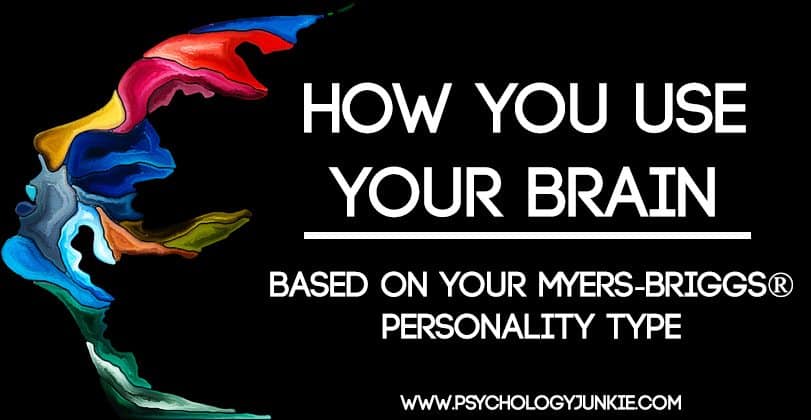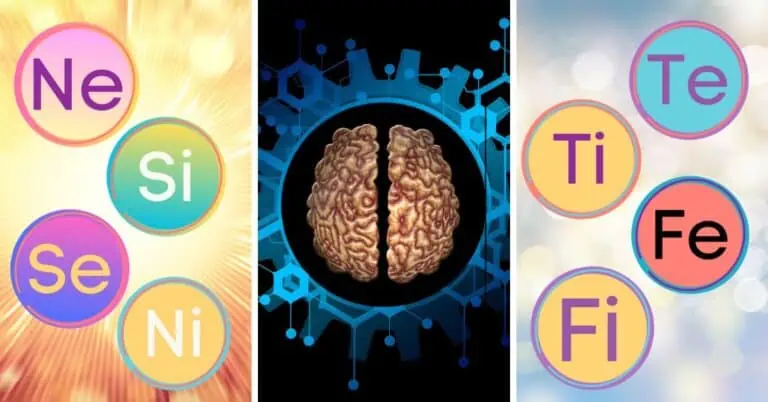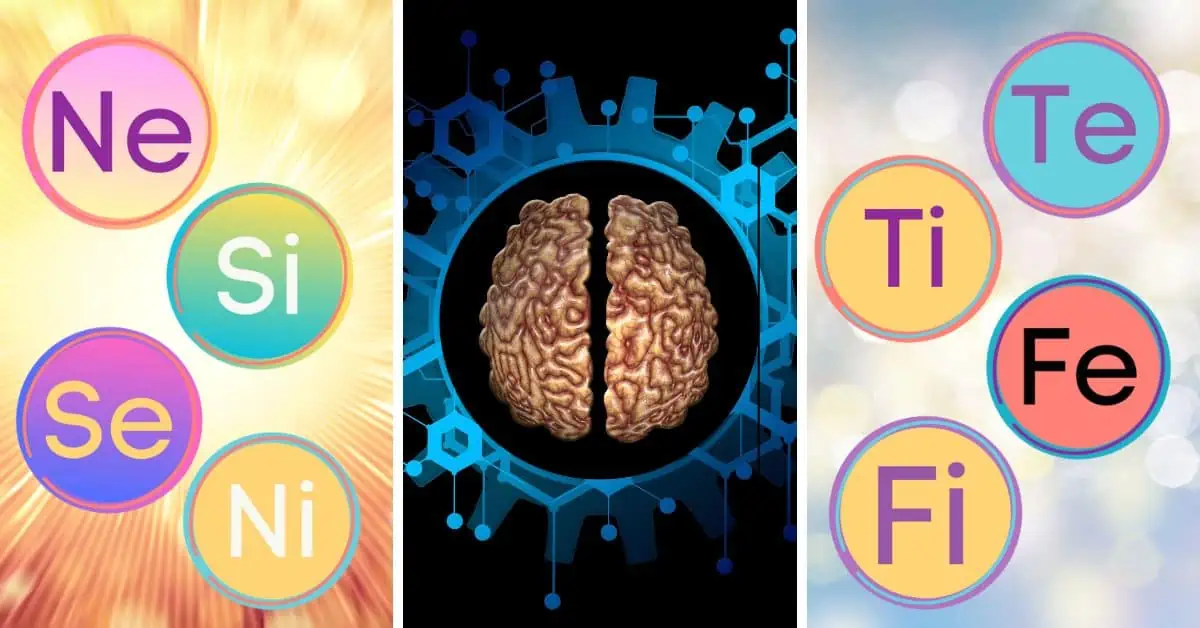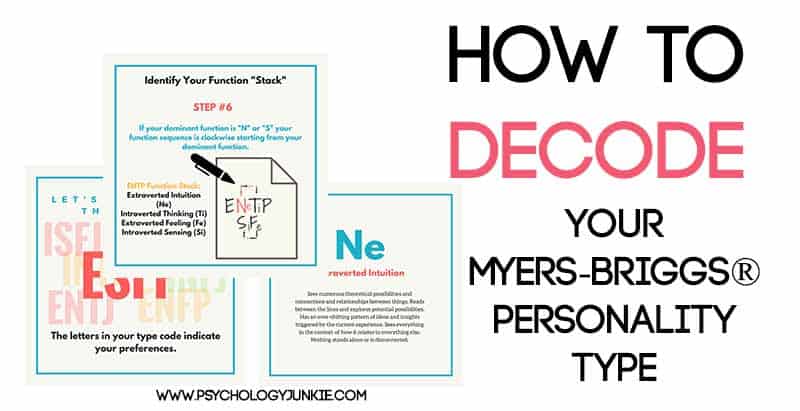Your Myers-Briggs® Personality Type and Your Brain
Did you know that every personality type uses their brain differently? Certain types rely heavily on one set of brain regions, while another type relies heavily on a completely different set of regions. There have been numerous studies done on this subject. Neuroscience expert Dario Nardi has written in detail about this in his book (which I strongly recommend reading!) Neuroscience of Personality: Brain Savvy Insights for All Types of People. The official MBTI® Manual lists at least six studies that were done by various psychiatrists and neuroscientists to measure brain activity in relation to type. This research is often ignored in arguments against the MBTI®. In fact, most people who disagree with the Myers-Briggs® assessment haven’t even gone to the trouble to read the official MBTI® Manual which showcases the results of literally hundreds of reliability and validity tests and improvements made to the indicator.
If you’re looking for the nitty-gritty neuroscience behind personality type, this article is a good start (but I definitely recommend checking out Dario Nardi’s book for lots more information). Keep in mind that every individual will have variations in how they use their brain based on training, unique traits, and possible mental illness.

Not sure what your personality type is? Take our new personality questionnaire here. Or you can take the official MBTI® here.
Table of contents
- Extroversion and Introversion Differences
- ISTJ Brain Activity
- ESTJ Brain Activity
- ISFJ Brain Activity
- ESFJs Brain Activity
- ISTP Brain Activity
- ISFP Brain Activity
- ESTP Brain Activity
- ESFP Brain Activity
- INFP Brain Activity
- ENFP Brain Activity
- INFJ Brain Activity
- ENFJ Brain Activity
- INTP Brain Activity
- ENTP Brain Activity
- INTJ Brain Activity
- ENTJ Brain Activity
- Want to know more?
Estimated reading time: 29 minutes
Extroversion and Introversion Differences
Studies have shown that introverts are more sensitive to dopamine activity in their brain. While extroverts and introverts both have the same amounts of dopamine, extroverts are more positively stimulated by it, and introverts are more negatively stimulated by it. Other studies have shown that extroverts demonstrate less cortical arousal than introverts do. This finding is significant in that it shows why introverts seek less sensory stimulation in their environment, while extroverts need more stimulation. What an introvert considers noisy, busy, painful, or overwhelming might seem “normal” to an extrovert.
When it comes to introverts, the ingredient essential to their happiness is a neurotransmitter called acetylcholine. Acetylcholine powers our abilities to think deeply, reflect, and focus intensely on just one thing for a long period of time. This may explain why introverts sometimes struggle with excessive multi-tasking or jumping from one project to another.
ISTJ Brain Activity
According to Dario Nardi, ISTJs show 47% of their pre-frontal activity on the left side of their brain, with 53% of their pre-frontal activity on the right side. They also show brain activity that reflects their training, background, and areas of expertise. This allows them to easily recall information they’ve learned “on the job” and helps them to specialize in various subjects.
The ISTJ brain shows strong use of memory for raw details and past experiences. They enter a “zone” like state when they recall past events and review them in detail. This is why many ISTJs enjoy talking about experiences they’ve had in the past and relaying exact details of how things happened and played out before. They may enjoy listening to favorite songs from their childhood, watching “home movies”, or writing journals about past experience.
ISTJs also show high activity in the back of their brain, or the occipital regions. These are the regions that handle and interpret images. Because of this, Si-users tend to excel at interpreting abstract visual impressions and tend to be visual learners as well.
ISTJs show high activity in the equator area that runs around the circumference of the brain. This region is active when we plan for the future, it also helps to recognize and evaluate facial expressions. Si-users often mistype as Ni-users because Ni is often associated with planning for the future, but Si-users also experience mental stimulation in planning ahead. ISTJs tend to have more practical plans (“what will I pack for my trip”, “what is my 10-year career goal?”, “how can I make sure my descendants are provided for?”) and Ni-users tend to have more theoretical questions or predictions (“VR will have this impact on society as a whole”, “I’m going to change the face of social media with this strategy”, “in 10 years the earth will be impacted this way by global warming”).
ISTJs respond strongly to social feedback. Negative social feedback (a frown, an offhand glance, a grimace) evokes strong feelings of embarrassment, shame, or apprehension. As a result, ISTJs often know how to adjust to social feedback and are extremely responsive to negativity.
Related: 10 Things That Terrify ISTJs
ESTJ Brain Activity
ESTJs show 52% of their pre-frontal activity on the left side of their brain, and 48% of their pre-frontal activity on the right side of their brain. They are very efficient with their mental energy so that they can maintain stamina during ongoing challenges. They rely most heavily on left-brain regions for hearing, seeing, remembering, and deciding. These key regions rely on measurable concrete information and give the ESTJ their famed evidence-based decision-making skills. These regions also allow them to generally have good hand-eye coordination, diction, and a propensity for arranging information in charts, tables, and diagrams.
ESTJs rely heavily on a section called FP01. This is located in the front-central portion of the brain by the eye socket. This region notes errors in the environment, and filters out undesirable information, including negative criticism or feedback. People with high activity here can ignore a lot of negatives because they are quick to move past it or suppress it. This is why ESTJs tend to easily critique or point out errors that they see, but they can also filter out or block negative feedback or evaluations from others and not get “riled up” by it. This region also helps them to suppress emotional responses. ESTJs tend to take life in stride and are not usually bothered by criticism, and FP01 may have a big part to play in that aspect of their personality.
Finally, ESTJs show high activity in region F8 which handles emotional regulation, social inhibition, and emotional/personal values. Region F8 works in conjunction with FP01 to notice errors in values and emotional reactions. Accordingly, ESTJs experience high brain activity when there is a negative value-judgment made against something or someone, such as “stupid idea”, “immoral decision”, or “corrupt individual”.
Related: What Type of Sensor Are You? The Difference Between Introverted and Extraverted Sensing
ISFJ Brain Activity
ISFJs show 45% of their pre-frontal cortex activity in the left side of their brain, and 55% of their pre-frontal cortex activity in the right side of their brain. They show brain activity that reflects their training, background, and area of expertise. As a result, they have very strong use of memory and can recall raw details with precision.
ISFJs enter a “zone” like state when they recall past events and review them in detail. This is why they often enjoy relaying favored experiences from their past or watching “home movies” from their childhood. They enjoy thinking and concentrating on their favorite past experiences, remembering every detail with vivid accuracy.
ISFJs show high activity in the occipital regions of the brain. These are the regions that handle and interpret images. As a result, ISFJs tend to have excellent skill in interpreting abstract visual impressions and are often visual learners.
Like ISTJs, ISFJs show high activity in the equator area that runs around the circumference of the brain. This region is active when we plan for the future, it also helps to recognize and evaluate facial expressions. Many ISFJs mistype as INFJs on personality tests because many tests are written to interpret future planning as relating to intuition. However, Si-users consistently show high activity in areas that help them plan for the future. In general, Si-users will have more practical plans (“how will I decorate my future home?”, “what is my 5-year career goal?”, “will my family be provided for if I’m gone?”) and Ni-users will often have more theoretical predictions or questions, (“What are my beliefs on existentialism?”, “Are people inherently evil or good?”, “This people group will be adversely affected by ___ politics”).
ISFJs show high activity in the temporal region that helps them to adjust to social feedback. ISFJs show tremendous activity here when they receive negative social feedback, such as a frown or body language conveying discomfort. As a result, they may be more easily embarrassed or more quick to respond to a social change in their environment. Interestingly, male ISFJs tend to show more activity in this region than female ISFJs.
Related: Understanding ISFJ Feeling
ESFJs Brain Activity
ESFJs show 52% of their pre-frontal cortex activity in the left side of their brain, and 48% on the right side of their brain. Their brain shows high activity in areas that reflect their social responsibilities. This can explain why they are usually very planful, conscientious, and committed to their communities. They also use neocortex regions that help them to communicate effectively and evaluate other people’s behavior.
ESFJs show a lot of activity in FP01, a brain region on the front-left side of the frontal lobe. This activity helps them to notice errors in their environment, and to suppress negative or distracting input. FP01 also helps to suppress emotional impulses in favor of more advanced cognitive responses. For example, an ESFJ might hear about the death of someone she loves and try to remain composed yet use language to express her feelings (“I am devastated”, “This breaks my heart”). ESFJs tend to use FP01 to ignore bad news in favor of being optimistic.
ESFJs show high activity in the temporal region that helps them to adjust to social feedback. This part of their brain “lights up” when they receive negative social feedback, such as a frown or body language conveying discomfort. As a result, they may be more easily embarrassed or more quick to respond to a social “upset” in their environment.
ESFJs show high activity in regions C3 and F7. C3 is located on the top of the primary somatosensory cortex. This part of your brain is responsible for processing touch and sensation as well as keeping track of the location of your body parts. This plays into the “sensory” part of their personality. They are usually well aware of where they stand, where they move in relation to other people, and how things physically affect them. F7 is part of the frontal cortex, and this region integrates sensory information with data retrieval from memory locations. This relates to the Introverted Sensing (Si) part of the ESFJ personality. They compare present and past experiences and data to see if they match up. They also are good at recalling facts and following pre-ordained steps.
Related: Understanding ESFJ Feeling

ISTP Brain Activity
ISTPs show 59% of their pre-frontal cortex activity in the left side of their brain, while 41% of their activity occurs on the right side of the pre-frontal cortex. They show extremely focused use of four regions that work to analyze complex problems and find logical solutions. One of these regions, F3, is located in the left side of the dorsolateral prefrontal cortex. This region is highly activated in ISTPs and helps them to linearly derive solutions using verbal or symbolic reasoning. This region also manages motor planning and fine motor coordination. The high activity in F3 could explain why ISTPs are known to be physically coordinated and excellent at problem-solving.
ISTPs also show high use of region F4, which is responsible for fine motor coordination and sensory guidance of movement. Neurons here are responsive to tactile stimuli, visual stimuli, and auditory stimuli. Region F4 also helps ISTPs to define and categorize concepts and sorts many categories simultaneously. This would explain why ISTPs (and Se-users in general) have good hand-eye coordination and tend to respond quickly to physical changes in their environment. They also can handle a lot of concepts and data at one time.
ISTPs use the right parietal brain region P4 to weigh pros and cons and determine what choice is best in a crisis or risky situation. P4 is also the site where we distinguish ourselves in space; it determines where “I” end and the rest of the world begins. People with high use of P4 tend to be very physically aware of their presence and are less likely to bump into things. P4 is also helpful in handling complex math problems.
ISTPs (and INTPs) tend to show very little interest in listening. They show very little activity in the right and left temporal lobes, which are the areas that usually “light up” when someone is listening actively to another person. Interestingly, female ISTPs are somewhat more attentive listeners, though they have to make a concerted effort.
Related: The Rare ISTP Female
ISFP Brain Activity
ISFPs show 68% of their pre-frontal activity on the left side of their pre-frontal cortex, and 32% activity on the right side of their pre-frontal cortex.
ISFPs show extremely strong activity in the right and left temporal lobes. One of these regions, T3, is located in the temporal lobe and handles language, including verbal memory, phonological processing, diction, grammar, and voice tone. As a result, ISFPs hear with precision and accuracy. They also are very careful about how they say things and are particular about which words they use and the manner in which those words are spoken. T4 handles emotional attention, emotional non-verbal memory, and also helps to weigh motivation and intent. ISFPs are extremely aware of other people’s voice tones and are quick to spot phoniness, dishonesty, or hidden intentions and this may be as a result of high activity in regions T3 and T4. T5 lights up when an ISFP is curious about someone’s thinking. They use this area specifically when people withhold information or when feedback isn’t given. They are very aware of what isn’t said.
In the full-frontal lobe, ISFPs show high activity in region F8. This is the site responsible for emotional expression, right-handed drawing, and mood regulation. It is also the area that is stimulated when we rank things in order of importance or when we discuss our values. This would coincide with ISFPS being Fi-dominant. Fi-users are extremely concerned with maintaining their inner value system, and they also tend to be emotionally expressive, although they often express their emotions through an art form or an indirect way.
Finally, ISFPs show high activity in the temporal homologous site where T6 is located. This area aids in emotional understanding, facial recognition, symbol recognition, and auditory processing. It can also help with calculating what will come next in the future. This would fall in line with ISFPs having tertiary Introverted Intuition (Ni) which is adept at understanding symbol recognition and predicting future events.
ESTP Brain Activity
The average ESTP has 46% of their pre-frontal activity on the left side of their brain, with 54% on the right side of their pre-frontal cortex. They also are famous for showing a “tennis hop” brain pattern on EEG scans. If you imagine a tennis player, you’ll see that they hop lightly from foot to foot while they await the return of the ball. This helps them to maintain momentum and respond quickly. ESTPs use this brain pattern to engage all regions of the neocortex, but they are each low amplitude and out of synch. This is a very effective state in that it allows the brain to quickly delegate whichever regions are necessary for a surprise, incoming problem or job. This can explain why ESTPs tend to remain calm in crisis situations. Their brain is generally ready for anything surprising or alarming that is thrown its way.
ESTPs also tend to reach a “zone” like state when they engage in crisis situations. While other types may panic or freeze up when a disaster strikes, ESTPs are able to remain calm and think quickly to find creative and effective solutions. ESTPs are also quick on their feet. They rely on brain regions that help to quickly integrate body and sensory information. They are highly adept at physical, concrete tasks and can reach another focused, relaxed state when they engage in physical tasks like juggling.
Because ESTPs are mentally wired to always be ready for action, they are frequently bored when having to sit still. This can cause problems when they have to spend a lot of time in traditional classroom settings. Their brains remain active and ready for a “surprise” or incoming problem, and instead of that need being satisfied, they are told to sit still and listen. If they could have the opportunity to stretch or walk around they would probably be able to absorb more information readily.
Finally, ESTPs have the strongest use of any of the personality types in full frontal lobe region F3. This region helps them to find linear solutions, maintain fine motor coordination, engage in logical problem-solving, and reach conclusions by sorting through a plethora of facts.
Related: Understanding ESTP Sensing
ESFP Brain Activity
People with the ESFP personality type show 48% of their pre-frontal activity on the left side of their brain, and 52% of their pre-frontal activity on the right side of their brain. Like ESTPs, ESFPs show a “tennis hop” brain pattern in EEG scans. This pattern engages all regions of the neocortex and allows them to quickly delegate whichever regions are necessary for a surprise, incoming problem or job. This can explain why ESFPs tend to remain calm in crisis situations. Their brain is alert and ready for changes, surprises, and “plot twists”.
Also, like ESTPs, ESFPs enter a “zone” like state when they engage in crisis situations. Only ESTPs and ESFPs showed this kind of zoning under stress. Many other types panic or freeze up. ESFPs can become bored in sedentary activities because their brain is always ready for surprises and action. As Nardi says in Neuroscience of Personality: Brain Savvy Insights for All Types of People, “Quietly sitting in a classroom or office doing pencil-paper work is like a tennis player waiting endlessly on a court for a game with no opponent and no ball.”
ESFPs favor details that are dramatic or show high-motion. They can easily recall the details of a dramatic scene or example that they were shown fifteen minutes earlier. This could also explain why ESFPs tend to be very stimulated by the sensory world and engaging in highly-stimulating environments with a lot of creative details.
ESFPs rely heavily on the right and left temporal lobes. These regions process verbal memory and emotional non-verbal memory. They also handle language including diction, grammar, and voice tone. Because of this, ESFPs hear with intense accuracy and attentiveness and are also very careful about how they use words. The delivery and overall message are very important to them.
Related: 10 Things You Should Never Say to an ESFP

INFP Brain Activity
People with the INFP personality type show 52% of their pre-frontal activity on the left side of their brain, and 48% of their pre-frontal activity on the right side of their brain. They are known for being excellent listeners because they engage all brain regions that process voice, words, and volume. Unlike other personality types who may work out their response while someone else is speaking, INFPs use this holistic-listening pattern as long as possible so that they can try to get to the core of who someone is and what they’re saying.
INFPs also show high activity in the right and left temporal lobes. These regions process verbal memory and emotional non-verbal memory. They also handle language including diction, grammar, and voice tone. Because of this, INFPs hear with precision and accuracy and are very particular about the words they use, and the volume and tone at which they speak. They are also attuned to whether or not the way someone is speaking seems authentic or dishonest.
INFPs show tremendous activity in the full frontal lobe region F8. This region is involved with emotional expression and mood regulation. It can also be used when we categorize things in order of importance or discuss our values. When we say things like “my drawing” or “my beliefs”, we use region F8. This would coincide with INFPs being especially driven by their values and having highly nuanced forms of emotional expression.
INFPs show less activity in interior regions of the brain that aid in logic. As a result, they may struggle with deducing, classifying, and defining. However, they use moderate activity in visual and kinesthetic regions that aid in pattern recognition, perception, color perception, data recall, and recall of aesthetic qualities or whole-body experiences. This would fall in line with INFPs having tertiary Introverted Sensing (Si) since Si is related to recalling past events and experiences with accuracy.
Finally, INFPs show increased activity in the frontal region F7. F7 is used for verbal expression, speech fluency, mood regulation, and engaging in mental rehearsal to apply context to words. This region also helps us “step into” another person’s shoes and empathize. According to Stress Therapy Solutions, region F7 also helps us to decode the intentions of others.
Related: Why INFPs and INFJs Are Drawn to Sad Things
ENFP Brain Activity
People with the ENFP personality type show 48% of their pre-frontal activity on the left side of their brain, and 52% of their pre-frontal activity on the right side of their brain. ENFPs (and ENTPs) are known for using a process called trans-contextual thinking. Whenever a stimulus enters the brain, the ENFP responds by quickly processing the stimulus in numerous regions, including regions that have nothing to do with the stimulus. Nardi says in his book The Neuroscience of Personality “for most people, hearing the word “dog” and “cat” will evoke auditory regions like T3 and perhaps some visual or memory regions like O1 and C3….However, the Ne types get busy using all regions to tap relationships across situations, perhaps suddenly imagining a story about two brothers, one of whom is faithful and sociable (like a dog) while the other is independent and quiet (like a cat). They might wonder about dog and cat writing styles as well.”
ENFPs also show high activity in frontal region F7. F7 thinks about context, is concerned with verbal expression, speech fluency, mood regulation, empathy, and assessing the intentions of others. Some people call this the “frontal mirror neuron system”. This amazing region not only gives ENFPs their signature empathy, but it also helps them to think across contexts to create fast, creative responses. Activities that stimulate the ENFP would include engaging in “what-if” questions, playing word games, or analyzing ambiguous meanings. Most feeling types tend to show more activity in this region.
Brain regions that support imagination are used intensely by ENFPs and can explain why they are often drawn to career fields in the arts. They also show activity in the right and left temporal lobes that handle language, including verbal memory, emotional non-verbal memory, and phonological processing. They are very careful about the words they use and think carefully about timing and delivery so that they can get the desired impact.
ENFPs may struggle with entering a “zone” state. They tend to have to practice at something for a long time before they can find “flow”. Once they become proficient at an activity for a long time, they can find this state by envisioning themselves doing something they are especially good at.
INFJ Brain Activity
People with the INFJ personality type show 49% of their pre-frontal activity on the left side of their brain, and 51% of their pre-frontal activity on the right side of their brain. INFJs (and INTJs) use a whole-brain, zen-like pattern regularly. According to Dario Nardi, “this pattern occurs when all regions of the neocortex are in synch and dominated by brain waves that are medium-low frequency and very high amplitude.” Other personality types show this pattern when they are engaged in an area of expertise (for example, a trained performer acting in a play). The curious thing about INFJs is that they show this state whenever they are asked to do the opposite. For the INFJ this zen-pattern occurs when they have to tackle an unfamiliar, unusual problem or envision the future. When given a problem or mystery, INFJs try to harness all neocortex regions in order to “realize” an answer. Each brain region offers a different perspective, and the INFJ is able to reconcile various unusual perspectives to find a best-fit answer or strategy to a mystery or puzzle. INFJs are happiest when they use their brain in this way. They are most able to reach this state when they are free from sensory distractions, interruptions, or demands. This is why most INFJs need regular alone time in a quiet environment where they can use their preferred mental process at its full potential.
INFJs also show strong activity in temporal region T6. T6 is in charge of predicting as well as recognizing symbols and faces. We use this part of our brain when we make a statement like “this will happen” or when we project or strategize about the future. We also use this part of our brain when we give symbolic meaning to images. This all falls in line with INFJs being Ni-dominant and Ni being focused on making predictions and thinking symbolically.
INFJs dislike rote practice or repetition. They like to keep their minds open to burning new neural pathways at all times. This means that they are generally not “specialists” in a particular activity. Instead of repeating a process to perfection, they mentally seek out new information and methods.
INFJs rely heavily on occipital regions O1 and O2. These regions are in charge of visual processing and pattern recognition. They also show increased activity in the prefrontal region FP2. This region is used when a person deals with novel information, admits negative input, and mutes emotional responses so reflection on negative input can occur. This area is active when we ponder our sense of self, use self-control, and restrain our impulses. INFJs take time to consider various perspectives by using their whole-brain pattern and also by using FP2 regularly.
Finally, INFJs show tremendous activity in frontal region F7. This region helps us “step into” another person’s shoes and empathize, engage in mental rehearsal, and consider verbal expression. According to Stress Therapy Solutions, region F7 also helps us to decode the intentions of others.
NEW! Embrace your INFJ journey with my newest eBook! Discover 19 chapters packed with in-depth INFJ information. You’ll also find practical tips for reducing stress, maximizing relationships, improving creativity and more!
Related: 7 Things That INFJs Experience as Children
ENFJ Brain Activity
People with the ENFJ personality type show 63% of their pre-frontal activity on the left side of their brain, and 37% of their pre-frontal activity on the right side of their brain. ENFJs rely on neocortex regions that help them to communicate effectively, analyze other people’s behavior, make plans, and examine complex problems. ENFJs show increased activity in the frontal region FP1. FP1 focuses on logical attention, networking, inter-personal communications, task completion, and decision making. This correlates with ENFJs being goal-oriented and decisive as well as being strong communicators. Region FP1 also notes errors in the environment and filters out unnecessary input or negative feedback. This area is often used when people work past distractions or minimize options so they can focus on one objective. On the other hand, over-use of this area can mean that the user filters out criticism, alternate viewpoints, and negative feedback to an unhealthy degree.
ENFJs show low activity in the frontal region FP2. FP2 helps us to introspect, restrain impulses, analyze our sense of self, and apply disruptive information at the cost of feeling depressed. If FP2 is extremely dismissed or unused, this can result in ENFJs suddenly going from very composed to furiously angry. When ENFJs combine the use of Extraverted Feeling (Fe) with strong use of Introverted Intuition (Ni) they are able to avoid bypassing FP2 because Ni is very reliant on the FP2 region. ENFJs who dismiss Ni or are in a Fe-Se loop will have more issues with anger and poor self-control.
ENFJs show high activity in temporal region T5. T5 works with logical and verbal understanding, word recognition, auditory processing, and adjusting to social feedback. People with high activity in region T5 are highly responsive to negative social feedback and can be easily embarrassed or feel guilt or shame over negative interactions with others. This may explain partially why ENFJs are so driven to maintain harmony and for social interactions to go smoothly. Interestingly, male ENFJs show more activity in T5 than female ENFJs.
ENFJs rely heavily on the left temporal lobe This area analyzes speech, diction, and grammar and us of this region can explain why many ENFJs (and ESFJs) are very particular about the words they use and the way they are arranged.
ENFJs show high activity in the Mesial Motor Strip area C4. This area is used when we understand music, process emotions, use whole-body motion, and assess people’s intentions. They also show strong use of frontal lobe area T4. This area analyzes emotions and helps us to maintain an autobiographical memory.

INTP Brain Activity
People with the INTP personality type show 51% of their pre-frontal activity on the left side of their brain, and 49% of their pre-frontal activity on the right side of their brain. They show high use of four important regions that are involved with complex logical reasoning. The first region, F3, helps the INTP to linearly derive solutions using verbal/symbolic reasoning. It is also is involved with fine motor coordination and motor planning of the upper body. Secondly, INTPs show strong use of frontal region F4, which helps to categorize and define concepts and use fine motor coordination of the left hand. The third region INTPs use heavily is region P3 which aids in language processing, logical reasoning and memory, imagination, spelling and short-term memory, math calculations, naming objects, complex grammar, and sentence construction (whew! P3 is pretty important!). They also show strong use of the right parietal region which aids in image and spatial processing, spatial memory, map orientation, sense of self in space, and weighing pros and cons in an uncertain or risky environment. This region is most heavily used by ENTPs, followed by ISTPs, then INTPs.
Like ISTPs, INTPs show very little interest in actively listening to other people. They show extremely low activity in the right and left temporal lobes which process auditory input, sound and voice intonation, linguistic perception and social cues. They have to make a much more concerted effort to actively listen than most other personality types. Interestingly, female INTPs are better listeners, but it is still a somewhat difficult process.
When INTPs are engaged in a debate, interesting discussion, or argument, they show strong use of frontal regions FP1 and FP2. When these two brain regions work together they allow the user to see a problem from multiple angles, with both positive and negative input readily available. They also are able to integrate these different angles in a coherent viewpoint.
Related: 10 Things You Should Never Say to an INTP
ENTP Brain Activity
People with the ENTP personality type show 48% of their pre-frontal activity on the left side of their brain, and 52% of their pre-frontal activity on the right side of their brain. Like ENFPs, ENTPs are known for their “Christmas tree” brain pattern. This pattern is called trans-contextual thinking. In this pattern, the neocortex is active all over, and each region has a high amplitude and is out-of-synch with the others. Each region is processing information and working to generate a creative, surprise result. While most personality types focus on particular brain regions to answer certain questions, ENTPs use trans-contextual thinking to include brain regions that seem to be unrelated to the question at hand. However, this helps them to discover unusual relationships between situations. Nardi explains this in his book The Neuroscience of Personality; “Most people, hearing the words “dog” and “cat” will evoke auditory regions like T3 and perhaps some visual or memory regions like O1 or C3….However, the Ne types get busy using all regions …perhaps suddenly imagining a story about two brothers, one of whom is faithful and sociable (like a dog) while the other is independent and quiet (like a cat). They might wonder about dog and cat writing styles too!”
Trans-contextual thinking is extremely energy-intensive, and ENTPs tend to experience very creative highs and also very strong lows as well. Because they bounce back and forth between so many different brain regions it can be natural for them to be mentally worn out at times. They may see so many sides to a situation or scenario that they find it hard to settle on one clear point.
ENTPs rely strongly on the right parietal region. This region acts like a visual-spatial sketch pad. It is in charge of facial decoding, integration with the environment, spatial memory, non-verbal reasoning, and weighing numerous pros and cons of many uncertain factors before arriving at a single result. ENTPs use this region most out of any of the other personality types.
INTJ Brain Activity
People with the INTJ personality type show 48% of their pre-frontal activity on the left side of their brain, and 52% of their pre-frontal activity on the right side of their brain. INTJs show a whole-brain, zen-like pattern when they process information. Dario Nardi says that “this pattern occurs when all regions of the neocortex are in synch and dominated by brain waves that are medium-low frequency and very high-amplitude.” Other personality types show this pattern when they are engaged in an area of expertise (for example, a trained chef making their specialty dish). The curious thing about Ni-dominant types is that they show this state whenever they are asked to do the opposite. INTJs and INFJs show this zen-pattern when they have to tackle an unfamiliar, unusual problem or envision the future. When given a problem or mystery, INTJs try to harness all neocortex regions in order to “realize” an answer. Each brain region provides a different perspective, and the INTJ is able to reconcile various unusual perspectives to find a best-fit answer or strategy to a problem or puzzle. INTJs are happiest when they use their brain in this way, and are most able to reach this state when they are free from sensory distractions, interruptions, or demands. This is why most INTJs need regular alone time in a quiet environment where they can use their preferred mental process at its full potential.
INTJs also show high activity in the temporal region T6. T6 is in charge of predicting, understanding emotions, facial recognition, and symbol recognition. We use this part of our brain when we make a prediction, as in “this will happen” or when we project or strategize about the future. We also use this part of our brain when we give symbolic meaning to images. This all falls in line with Ni being focused on making predictions and thinking in symbolic images.
INTJs dislike rote practice or repetition. They like to keep their minds open to burning new neural pathways at all times. This means that they are often not “specialists” in a particular activity. They are eager to keep seeing things from new perspectives and to continually learn new things instead of focusing on one specialized area over and over again.
Finally, because INTJs use Extraverted Thinking (Te) they use efficient mental energy. They show brain activity in left-brain regions for hearing, seeing, recalling, and deciding. This allows them to quickly manage measurable information to make an evidence-based decision. This also means that they are stimulated by task completion and error-correction.
Related: When INTJs Loop – Understanding the Ni-Fi Cycle
ENTJ Brain Activity
People with the ENTJ personality type show 63% of their pre-frontal activity on the left side of their brain, and 37% of their pre-frontal activity on the right side of their brain. They are very efficient with their mental energy so that they can maintain stamina during ongoing challenges. They rely most heavily on left-brain regions for hearing, seeing, remembering, and deciding. These vital regions rely on measurable concrete information and give the ENTJ their famed evidence-based decision-making skills. These regions also allow them to generally have good hand-eye coordination, diction, and a propensity for arranging information in charts, tables, and diagrams.
ENTJs rely heavily on a section called FP01. This is located in the front central portion of the brain by the eye socket. This region notes errors in the environment and filters out undesirable information, including negative criticism or feedback. This is why ENTJs tend to easily critique or point out errors that they see, but they can also filter out or block negative feedback or evaluations from others and not get “riled up” by it. They can also filter out unnecessary data to zone in on key points. This region also helps them to suppress emotional responses.
Finally, ENTJs also show high activity in region F8 which handles emotional regulation, social inhibition, and emotional/personal values. Region F8 works in conjunction with FP01 to notice errors in values and emotional reactions. Accordingly, ENTJs experience high brain activity when there is a negative value-judgment made against something or someone, such as “stupid plan”, “dumb idea”, or “selfish person”.
Want to know more?
Be sure to check out Dario Nardi’s book, Neuroscience of Personality: Brain Savvy Insights for All Types of People
Find out more about your personality type in our eBooks, Discovering You: Unlocking the Power of Personality Type or The INFJ – Understanding the Mystic. You can also connect with me via Facebook, Instagram, or Twitter!

The MBTI® Manual – Third Edition
This article contains affiliate links. I only recommend products I truly believe in.













Lovely work, just spot on!
Thank you!!
Amazing article.
Hi Susan Storm, I was just wondering how you became a MBTI Practitioner and gather all this information.
Hi Arthur! I got my MBTI® certification through CAPT (the Center of Applications for Psychological Type). It’s a week-long training program that you attend. Other than that I’ve just been reading as many books as I’ve been able to find on type. I hope that helps to answer your question!
Oh cool! Thanks for the reply.
I’m trying to soak up all of this rich information!! So interesting to have a glimpse into the science behind who we are.
I see you quoted Nardi a few times- would you say his book on The Neuroscience of Personality was your main source for this article? It’s on my “to read” list now.
Also, do you know if the left brain/right brain percentages were accurate in the case of each person of a particular type? Is there research to suggest that ALL INFJs use right brain more than the left, or did it just average out to that percentage that a majority of INFJs use right brain more than left?
Thank you!
ENTJ and ESTJ have the same exact description. Please fix.
They both have very similar mental processes because they are both dominant Te-users and inferior Fi-users, but their descriptions are’t the same. Some of the information is repeated because they have the same preferred mental processes, but if you read both descriptions they are both different.
Great article. I have mapped MBTI to the regions of the brain. This info shows my P/J to be reversed for Introverts than I had initialy figured. Thanks for this research.
This article is very biased towards the Extroverted and Sensing types. The author is obviously an ESFx …. cuz no one with an ounce of logic in their head would have 5 children in this hellscape we call a planet and actually enjoy it. She also self identifies as a parent above all in her bio. So perhaps she should delete her piece of crap website and just focus on being a mom. You are terrible at this, really, nobody likes a junkie. Please quit, so I don’t have to keep being compelled to read this garbage.
Go away. Get a life.
Perhaps you’re missing a few personality functions. Or perhaps you the morning you typed that comment you decided “Shit, my life sucks and I need to share this pain on the internet”.
Well, we don’t give Trolls much reliability when considering if their opinion is valid or not.
Anyways I do hope things are going better for you, or Atleast that you’ve found a better coping mechanism.
– ENTP
How can brain activities measurements be biased? I smell jealousy lol.
BTW, the arthor is an introvert, INFP IIRC.
One person can have many roles and can be proud to whatever they want. Being a parent certainly doesn’t make someone less worthy. In fact, even more so if they are good parents. I’m grateful for my mom whose decisions literally saved our lives.
-ISTJ who was brought up on some pretty FU’d dysfunctional family
Can you create a chart that shows left-brain and right-brain activity for all the types, percentage-wise, on a spectrum with left-“center”-right. I see so far: INFP, INTP “CENTER” INFJ, INTJ, but I think having a visual spectrum could be informative. I have noticed that INF and INT switch up from left to right on the left and right side of “center”. Ps on the left and Js on the right, at least for these 4 types. It would be interesting to see what pattern is there, and what that might reveal. I can do this myself, and will, but I think it could be useful and possibly revealing to individuals who visit the site.. Thanks!
Hi, I am an infj but I am 52% left brain and 47% right brained. Is it normal for an infj to have this combination? Please reply.
MBTI is the way, the truth and the life. No one comes to self-improvement except through this assessment tool